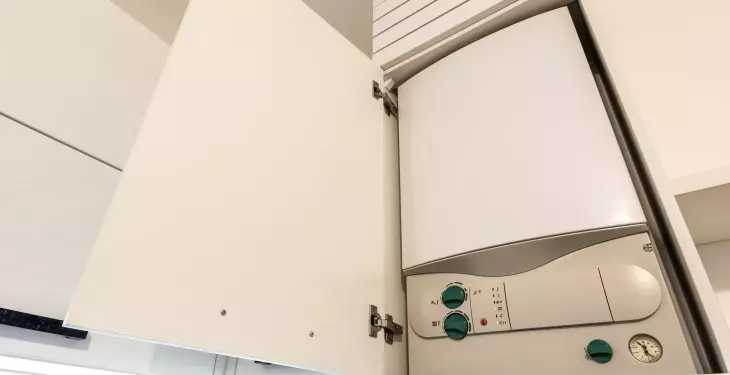

Written by Stephen Day
Gas Safe Engineer
Updated: 30th May, 2025
Boiler frost protection is an important feature that helps prevent your boiler from freezing and breaking down in cold weather. Our guide explains how boiler frost protection works, including the use of thermostats, sensors, and insulation, and provides tips on how to maintain and optimise your frost protection system.
Get a new boiler quote, save up to £550 per year (0% APR available).
Boiler frost protection is a crucial safety feature that ensures the smooth functioning of a heating system during cold weather. It prevents the water inside the system from freezing, which, if not addressed, could lead to breakdowns or even significant damage to the boiler.
Installed in areas susceptible to freezing such as garages or lofts, modern boilers pack this essential feature to guarantee their efficient, uninterrupted performance when temperatures plummet.
Get a quote in 60 seconds, fitted as fast as next day!
0% APR finance available.
Understanding how boiler frost protection works is fundamental for homeowners and property managers who need to safeguard their systems from frost damage during winter.
The mechanism involves the activation of boiler heating when the system senses a drop in water temperature to a specific threshold, typically around 5°C. In doing this, frost protection secures the boiler's functionality while averting potential calamities often associated with freezing temperatures and heating systems.
Boiler frost protection is an essential safety feature in modern boilers, designed to prevent freezing and potential damage to the system.
This feature works by monitoring the temperature of the water within the boiler and ensuring it doesn't drop too low.
In colder months, the risk of water freezing within a boiler system increases, which can lead to blockages and malfunctions, ultimately affecting the efficient functioning of the unit.
This is particularly relevant for boilers installed in areas such as garages or lofts, where ambient temperatures may reach freezing point.
Modern boilers often come equipped with built-in frost protection as a standard feature. Thermostats within the boiler regulate the temperature, and, when a drop is detected in the water temperature, the boiler is activated to maintain it above a specific threshold. This threshold is typically around 5 degrees Celsius to decrease the risk of freezing before the boiler can heat up sufficiently.
The implementation of frost protection is not only necessary for the system's safety but also enhances energy efficiency. By preventing blockages and ensuring that the boiler can run optimally, homeowners see a reduction in energy consumption and effectively prolong the unit's lifespan.
In summary, boiler frost protection is a valuable safety feature incorporated into many modern boilers. Its primary function is to protect the system from freezing, which can cause blockages and impair the boiler's overall efficiency. Utilising a thermostat, frost protection ensures the water temperature remains above a set level, safeguarding the unit and contributing to energy-efficiency gains.
Frost protection is a vital feature in modern boilers, particularly in locations prone to cold weather. It serves as a safeguard to ensure the smooth functioning and longevity of central heating systems by preventing potential water damage and costly repairs.

One significant advantage of having frost protection in boilers is the prevention of freezing in the internal components. With temperatures plunging during winter, water within the boiler and central heating system can freeze, causing pipes to burst and result in serious damage.
By activating the frost protection feature, the boiler raises the water temperature, reducing the risk of freezing incidents.
Moreover, investing in a boiler with frost protection can save homeowners their hard-earned money in the long run. The efficient prevention of freezing significantly lowers the likelihood of requiring costly repairs or even replacements of damaged central heating systems.
Additionally, a well-maintained system operates more efficiently, contributing to a reduction in energy bills.
From a safety perspective, frost protection is an indispensable attribute. In the unfortunate event of a frozen central heating system, not only will the boiler cease to function, but the risk of water damage within the residence increases as well.
By maintaining a safe temperature within the system, frost protection can alleviate the chances of such mishaps.
In conclusion, frost protection in boilers is an essential feature that promotes energy efficiency, reduces repair costs, protects the central heating system, and enhances household safety.
Although it may seem like a minor detail, it plays a significant role in keeping homes warm and secure during harsh winter months.
A boiler frost protection system is a critical feature in modern boiler systems, designed to prevent the water within the system from freezing during cold weather situations. This system typically comprises several components, all working together to ensure that the boiler functions efficiently and safely.
One of the main components in a boiler frost protection system is the thermostat. Thermostats, including smart thermostats, play an essential role in regulating the water temperature within the boiler system. A room thermostat detects when the temperature drops below a specific threshold, which is usually around 5°C. This detection prompts the boiler to turn on and heat the water to avoid any freezing.
Heating controls are another important aspect of the frost protection system. They allow users to manage heating settings, such as temperature and timings, and adapt the system based on weather conditions and personal preferences. Some advanced heating controls even offer weather compensation features, adjusting the boiler's operation to compensate for external temperature changes.
The heat exchanger is a vital component in a boiler system, as it is responsible for transferring heat from the burning fuel to the water in the system.
During the frost protection process, the heat exchanger efficiently warms the water in the system, keeping it above freezing point and avoiding damage to the boiler components.
Lastly, the condensate pipe plays a crucial role in the frost protection system. This pipe carries condensed water away from the heat exchanger, ultimately preventing the boiler from freezing.
However, the condensate pipe itself can be vulnerable to freezing. To combat this, proper insulation and even trace heating can be used to ensure the condensate pipe remains functional during freezing temperatures.
In summary, boiler frost protection systems rely on various components, including thermostats, heating controls, heat exchangers, and condensate pipes. Each component serves a specific purpose, working together to protect the boiler from freezing during cold weather conditions.
Boiler frost protection is an essential feature in heating systems to combat frozen pipes and potential damage during cold weather. It's designed to prevent water freezing within the heating pipes, thus averting disruption to the system and the risk of a burst pipe caused by expanding ice.
Frost protection is especially important for boilers located in external wall, garage, or loft spaces, as well as outdoor pipes.
The underlying principle of the frost protection mechanism is to constantly monitor water temperature. When the water temperature drops below a certain threshold, typically 5°C, the boiler kicks in to raise the temperature.
This action keeps the water within the heating pipes from freezing, hence preventing frozen central heating systems.
Apart from boiler-built frost protection, there are additional measures homeowners can implement to further secure their heating systems. One such approach is installing trace heating around outdoor pipes and vulnerable areas.
Trace heating involves adding an electric wiring system, which produces heat when powered, keeping pipes warm and preventing freezing.
Insulating heating pipes is another crucial preventive measure. By wrapping pipes with insulation materials, one can maintain the heat level inside the pipes and reduce the chance of freezing.
This method is especially effective when applied to outdoor pipes or those located in colder areas, such as a garage or loft.
Lastly, regular maintenance and observation of the heating system can help identify areas where freezing might occur.
By addressing these areas proactively, homeowners can avert potential damage caused by frozen pipes and maintain an efficient and trouble-free heating system.
In summary, boiler frost protection is a crucial feature that ensures the smooth functioning of heating systems during cold weather.
A combination of built-in frost protection, trace heating, insulation, and regular maintenance can further enhance the prevention of frozen heating systems, safeguarding against burst pipes and disruptions to your home's warmth and comfort.
Installing a boiler is a complex task, and it's vital to choose a skilled, Gas Safe registered professional for the job. A heating engineer with the right qualifications will ensure the boiler is installed correctly and safely. This, in turn, will aid in maintaining the efficiency and longevity of your heating system.
Employing an expert for boiler installation is crucial to achieving optimal performance. A professional will assess your property and heating needs, offering advice on the best boiler type and capacity for you.
Moreover, they'll guarantee the frost protection is correctly integrated, vital for protecting the unit from freezing temperatures and potential damage.
Apart from a proper installation, regular maintenance is vital for keeping your boiler in good working order. A Gas Safe registered engineer should be hired to carry out an annual service, ensuring the system is functioning optimally and efficiently.
This service includes checking all components and safety features, such as the frost protection mechanism, and addressing any potential issues before they escalate into costly repairs or breakdowns.
In conclusion, investing in a professional installation and regular maintenance by a Gas Safe registered heating engineer is critical for the effective operation of your boiler. This combination not only leads to a reliable, efficient heating system but also helps to preserve the life of the boiler and its frost protection mechanisms.
Boiler frost protection is an essential safety feature acting as a safeguard for your heating system, especially in colder climates. When not appropriately protected, boilers can suffer from a host of problems, such as burst pipes and damage to the system itself.
Burst pipes can occur when water inside the pipes freezes and expands. This expansion puts immense pressure on the pipes, causing them to rupture. The resulting damage can be extensive and lead to considerable water damage to the home, as well as potential structural issues.
In addition to burst pipes, water damage can also come in the form of leaks or overflowing due to ice blockages. Insulating pipes and ensuring proper frost protection with the boiler can reduce the likelihood of these issues arising.
Serious damage to the boiler itself can arise when frost protection fails in preventing the freezing of the water within the system. This can cause essential components of the boiler to malfunction or break, leading to costly and time-consuming repairs or even complete replacement of the unit.
The safety feature of boiler frost protection is not merely an optional add-on; it should be treated as a critical part of any boiler installation. It works by continuously monitoring the temperature of the water inside the system and activating the heating system when the water temperature falls below a predetermined safety threshold.
If the boiler does encounter frost-related issues, it is likely to display a fault code to inform you of the problem. Paying attention to these fault codes can help you identify the cause and enable a timely remedy.
In summary, boiler frost protection is vital in managing potential risks and damage to the heating system caused by cold weather conditions. With proper maintenance and temperature monitoring, you can stay confident in the safety and efficiency of your boiler and minimise the risk of potential damage.
Boiler frost protection plays an essential role in maintaining the efficiency and longevity of your heating system, particularly for boilers located in cold environments. It operates by heating the boiler when the water temperature falls below a certain threshold, preventing the system from freezing over.
The Vitodens range of boilers, for example, features built-in frost protection. This enables the appliance to monitor the water temperature and respond accordingly, ensuring that the boiler remains operational even during the coldest periods. Similarly, Vaillant boilers also offer frost protection capabilities, allowing homeowners to maintain their central heating system effectively during the winter months.
Most modern boilers now come equipped with frost protection features as standard. Manufacturers recognise the importance of safeguarding the system from freezing temperatures, which can cause pipes to burst and result in significant damage. As a result, many boilers now include sensors and controls that monitor internal temperatures and activate the frost protection mechanism when necessary.
It is worth noting that the compatibility of frost protection may vary depending on the type of boiler system. For instance, combi boilers typically have integrated frost protection features due to their compact design, while system and regular boilers may require external components, such as frost protection thermostats, to achieve optimal protection levels.
In conclusion, boiler frost protection is a vital aspect of maintaining the health of various types of boilers, including Vitodens, Vaillant, and other modern systems. By incorporating this feature, homeowners can ensure that their boilers remain efficient and reliable throughout the winter months, minimising the risk of system failure and potential damage caused by freezing temperatures.
Boiler frost protection is a safety feature designed to prevent the water inside your heating system from freezing. By maintaining the ideal temperature, frost protection helps to enhance the energy efficiency of your boiler, ensuring it works efficiently throughout the colder months.
One of the key benefits of boiler frost protection is the potential for significant cost savings on energy bills. A well-maintained temperature within the boiler system ensures that the boiler does not need to work excessively hard to heat the water, making it more energy-efficient. In turn, this translates to reduced energy consumption and lower energy bills.
Furthermore, boiler frost protection systems often work in conjunction with room thermostats and smart thermostats. These devices help to regulate the temperature within your living spaces, ensuring that you can maintain a comfortable environment without putting unnecessary strain on your boiler. By optimising the temperatures within your home, you can further boost energy efficiency and make even greater savings on your energy bills.
Not only does boiler frost protection enhance the energy efficiency of your heating system, but it also safeguards the water supply from potential blockages or damage caused by freezing temperatures. In doing so, you can avoid costly repairs or inconvenient situations such as a lack of hot water or heating during the winter months.
To summarise, boiler frost protection is an essential feature for maintaining the efficient and cost-effective operation of your heating system. By preventing freezing-related issues and working in tandem with thermostats, frost protection offers homeowners valuable energy savings and peace of mind throughout the colder months.
Boiler frost protection is a valuable feature of modern boilers, ensuring the system's reliability during cold periods. Nevertheless, modern boilers offer various additional benefits to homeowners which include their greater energy efficiency, compact design, and smart control integration.
Modern boilers are far more energy-efficient compared to older models. They often feature condensing technology, which captures and reuses heat from waste gases, resulting in less energy waste and lower heating bills. This not only benefits the users financially but also has a positive environmental impact by reducing carbon emissions.
Another significant advantage of modern boilers is their compact and space-saving design. In the past, boilers were typically bulky, requiring substantial space for installation. Nowadays, manufacturers have developed smaller, wall-mounted units that can be easily fitted in most homes. This allows homeowners to save precious square footage and better utilise the available area.
Lastly, modern boilers often integrate seamlessly with smart controls. These advanced systems provide users with the ability to remotely manage their heating schedules, temperatures, and energy consumption through mobile devices or smart home systems. Consequently, homeowners can enjoy greater convenience and potentially lower energy bills, given the more efficient use of their heating system.
Overall, boiler frost protection is just one of the many well-designed features of modern boilers that contribute to improving heating efficiency, comfort, and convenience for homeowners.
Check out new boiler costs
Last updated: 30th May, 2025

Written by Stephen Day
Gas Safe Engineer at iHeat
Stephen Day is a Gas Safe registered and FGAS certified engineer with over 20 years of hands-on experience in the heating, cooling, and renewable energy industry, specialising in boiler installations, air conditioning, and heat pump systems.
LinkedInArticles by Stephen Day are reviewed by iHeat’s technical team to ensure accuracy and reliability.

19th December, 2025
The best budget boilers are Ideal, Alpha, Baxi, Worcester Bosch and Vaillant models, compa...
 Read Article
Read Article

19th December, 2025
The most reliable boiler brands in the UK: Worcester Bosch, Vaillant, Ideal, Viessmann, an...
 Read Article
Read Article

19th December, 2025
An airing cupboard is a heated storage space that uses warmth from a hot water cylinder or...
 Read Article
Read Article
No obligation. Takes less than 60 seconds.